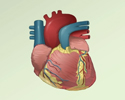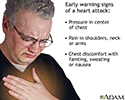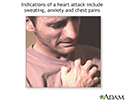Heart attack first aid
First aid - heart attack; First aid - cardiopulmonary arrest; First aid - cardiac arrestA heart attack is a medical emergency. Call 911 or the local emergency number if you think you or someone else is having a heart attack.
Heart attack
Most heart attacks are caused by a blood clot that blocks one of the coronary arteries. The coronary arteries bring blood and oxygen to the heart. ...

The average person waits 3 hours before seeking help for symptoms of a heart attack. Many heart attack patients die before they reach a hospital. The sooner the person gets to the emergency room, the better the chance of survival. Prompt treatment reduces the amount of heart damage.
This article discusses what to do if you think someone may be having a heart attack.
Causes
A heart attack occurs when the blood flow that carries oxygen to the heart is blocked. The heart muscle becomes starved of oxygen and begins to die.
Symptoms
Symptoms of a heart attack can vary from person to person. They may be mild or severe. Women, older adults, and people with diabetes are more likely to have subtle or unusual symptoms.
Symptoms in adults may include:
- Changes in mental status, especially in older adults.
-
Chest pain that feels like pressure, squeezing, or fullness. The pain is most often in the center of the chest. It may also be felt in the jaw, shoulder, arms, back, and stomach. It can last for more than a few minutes, or come and go.
Chest pain
Chest pain is discomfort or pain that you feel anywhere along the front of your body between your neck and upper abdomen.
 ImageRead Article Now Book Mark Article
ImageRead Article Now Book Mark Article - Cold sweat.
- Lightheadedness.
- Nausea (more common in women).
- Indigestion.
- Vomiting.
- Numbness, aching, or tingling in the arm (usually the left arm, but the right arm may be affected alone, or along with the left).
-
Shortness of breath.
Shortness of breath
Breathing difficulty may involve:Difficult breathing Uncomfortable breathingFeeling like you are not getting enough air
 ImageRead Article Now Book Mark Article
ImageRead Article Now Book Mark Article - Weakness or fatigue, especially in older adults and in women.
First Aid
If you think someone is having a heart attack:
- Call 911 for emergency medical help.
- Have the person sit down, rest, and try to keep calm.
- Loosen any tight clothing.
- Ask if the person takes any chest pain medicine, such as nitroglycerin for a known heart condition, and help them take it.
- If the person is unconscious and unresponsive, and not breathing or does not have a pulse, call 911 or the local emergency number, then begin CPR.
Unconscious
Unconsciousness is when a person is unable to respond to people and activities. Doctors often call this a coma or being in a comatose state. Other c...
 ImageRead Article Now Book Mark Article
ImageRead Article Now Book Mark ArticleCPR
CPR stands for cardiopulmonary resuscitation. It is an emergency life-saving procedure that is done when someone's breathing or heartbeat has stoppe...
Read Article Now Book Mark Article - If you are alone and an infant or child is unconscious and unresponsive, and not breathing or does not have a pulse, perform 1 minute of CPR, then call 911 or the local emergency number and immediately resume CPR. If two people are nearby, one should call 911 immediately while the other performs CPR.
- If the person is unconscious and unresponsive, does not have a pulse, and an automated external defibrillator (AED) is immediately available - follow the instructions on the AED device.
Many experts recommend chewing and swallowing a full dose aspirin (325 mg, or low dose 81 mg baby aspirin, after calling 911 or the local emergency number. Only do this if you have been instructed by a physician or a 911 operator, are not allergic to aspirin, and do not have any condition that could make taking aspirin dangerous for you. The 911 operator can also help you decide whether or not to take aspirin. Don't delay calling 911 to take an aspirin. Call for help first.
Do Not
- DO NOT leave the person alone except to call for help, if necessary.
- DO NOT allow the person to deny the symptoms and convince you not to call for emergency help.
- DO NOT wait to see if the symptoms go away.
- DO NOT give the person anything by mouth unless a heart medicine (such as nitroglycerin) has been prescribed.
When to Contact a Medical Professional
Call 911 or the local emergency number immediately if the person:
- Does not respond to you
- Is not breathing
- Has sudden chest pain or other symptoms of a heart attack
Prevention
Adults should take steps to control heart disease risk factors whenever possible.
- If you smoke, quit. Smoking more than doubles your chance of developing heart disease.
Heart disease
Coronary heart disease is a narrowing of the blood vessels that supply blood and oxygen to the heart. Coronary heart disease (CHD) is also called co...
 ImageRead Article Now Book Mark Article
ImageRead Article Now Book Mark Article - Keep blood pressure, cholesterol, and diabetes in good control and follow your health care provider's orders.
Diabetes
Diabetes is a long-term (chronic) disease in which the body cannot regulate the amount of sugar in the blood.
 ImageRead Article Now Book Mark Article
ImageRead Article Now Book Mark Article - Lose weight if obese or overweight.
Obese
Overweight and obesity mean having a weight than is higher than what is healthy for a given height. A person may be overweight from extra muscle, bo...
 ImageRead Article Now Book Mark Article
ImageRead Article Now Book Mark Article - Get regular exercise to improve heart health. Talk to your provider before starting any new fitness program.
- Eat a heart-healthy diet. Limit saturated fats, red meat, and sugars. Increase your intake of chicken, fish, fresh fruits and vegetables, and whole grains. Your provider can help you tailor a diet specific to your needs.
- Limit the amount of alcohol you drink. One drink a day is associated with reducing the rate of heart attacks, but two or more drinks a day can damage the heart and cause other medical problems.
References
Bonaca MP, Sabatine MS. Approach to the patient with chest pain. In: Libby P, Bonow RO, Mann DL, Tomaselli GF, Bhatt DL, Solomon SD, eds. Braunwald's Heart Disease: A Textbook of Cardiovascular Medicine. 12th ed. Philadelphia, PA: Elsevier; 2022:chap 35.
Glass GF, Brady WJ. Acute coronary syndrome. In: Walls RM, ed. Rosen's Emergency Medicine: Concepts and Clinical Practice. 10th ed. Philadelphia, PA: Elsevier; 2023:chap 64.
Lawton JS, Tamis-Holland JE, Bangalore S, et al. 2021 ACC/AHA/SCAI Guideline for Coronary Artery Revascularization: A Report of the American College of Cardiology/American Heart Association Joint Committee on Clinical Practice Guidelines. Circulation. 2022;145(3):e4-e17. PMID: 34882436 pubmed.ncbi.nlm.nih.gov/34882436/.
Writing Committee; Kontos MC, de Lemos JA, et al. 2022 ACC Expert consensus decision pathway on the evaluation and disposition of acute chest pain in the emergency department: A Report of the American College of Cardiology Solution Set Oversight Committee. J Am Coll Cardiol. 2022;80(20):1925-1960. PMID: 36241466 pubmed.ncbi.nlm.nih.gov/36241466/.
-
Heart attack symptoms - illustration
Symptoms of a heart attack may widely vary, from the classic elephant on the chest feeling of crushing pain, to the nausea and heartburn mistaken for indigestion. In some patients, the symptoms may only be sudden fatigue or an oppressive feeling of impending doom.
Heart attack symptoms
illustration
-
Symptoms of heart attack - illustration
Symptoms of a heart attack can vary widely and can mimic other conditions such as indigestion or heartburn. The important fact to know is to take all heart attack related symptoms seriously and seek medical help as soon as possible.
Symptoms of heart attack
illustration
-
Heart attack symptoms - illustration
Symptoms of a heart attack may widely vary, from the classic elephant on the chest feeling of crushing pain, to the nausea and heartburn mistaken for indigestion. In some patients, the symptoms may only be sudden fatigue or an oppressive feeling of impending doom.
Heart attack symptoms
illustration
-
Symptoms of heart attack - illustration
Symptoms of a heart attack can vary widely and can mimic other conditions such as indigestion or heartburn. The important fact to know is to take all heart attack related symptoms seriously and seek medical help as soon as possible.
Symptoms of heart attack
illustration
-
Burns
(Alt. Medicine)
-
Shock
(Alt. Medicine)
-
Anxiety disorders - InDepth
(In-Depth)
-
Systemic lupus erythematosus - InDepth
(In-Depth)
-
Epilepsy - InDepth
(In-Depth)
-
Acute lymphocytic leukemia - InDepth
(In-Depth)
-
Shingles and chickenpox (Varicella-zoster virus) - InDepth
(In-Depth)
-
Insomnia - InDepth
(In-Depth)
-
Travel to developing countries - InDepth
(In-Depth)
-
Colds and the flu - InDepth
(In-Depth)
Review Date: 10/7/2024
Reviewed By: Jesse Borke, MD, CPE, FAAEM, FACEP, Attending Physician at Kaiser Permanente, Orange County, CA. Also reviewed by David C. Dugdale, MD, Medical Director, Brenda Conaway, Editorial Director, and the A.D.A.M. Editorial team.




